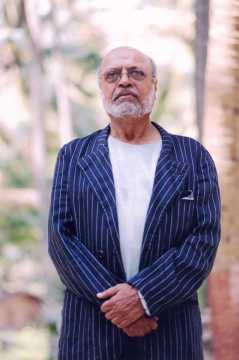The ace filmmaker got talking about his growing up years ahead of his 83rd birthday (14 December).
From secretly watching films to creating classics: Shyam Benegal gets nostalgic about his journey
Mumbai - 14 Dec 2017 9:00 IST
Updated : 23:55 IST


Keyur Seta
Shyam Benegal is one of India's more prolific filmmakers. The mere mention of his name is a reminder of several acclaimed works like Ankur (1974), Nishant (1975), Manthan (1976), Bhumika (1977), Junoon (1979), Kalyug (1981), Mandi (1983), Bharat: Ek Khoj (TV series), Mammo (1994), Netaji Subhas Chandra Bose: The Forgotten Hero (2005), and many others.
But few are privy to the interesting incidents early in his life that cultivated his deep interest in cinema. On his 83rd birthday (14 December), Benegal gets nostalgic thinking about his early association with the medium in an exclusive conversation with Cinestaan.com.
The director revealed that he was first introduced to the camera by his father. “My father was a still photographer," he said. "He had a studio. I was born and grew up in Hyderabad. Because he was a photographer, I think it rubbed off on us. But even more than that, he was a keen amateur filmmaker. He had a 16mm camera and he used to shoot films about his family, children, stuff like that.”

Naturally, the filmmaker and his long list of siblings (10 in total!) each had the privilege of starring in an individual film while growing up. “Since I come from a large family, my father had 10 children, he followed every child [with the camera] until the next child was born. So each child had a film devoted to his or her growing up,” he said with a smile. “That became a collection in my home. He used to show these films to his guests whenever they came home. So my interest in cinema started at home.”
But Benegal’s actual interest in films began in a cinema hall close to his Hyderabad home. “It was called Garrison Cinema," he recalled. "It used to be for the army garrison. I was born when the British were still in India. At that time, they used to show both Indian and British or American films. In the three weekend days, there used to be British or American films. On the remaining four days, they used to show Indian films. They used to show Telugu, Tamil, Hindi.”

Having watched a wide range of films at the theatre, he soon grew familiar with the medium. But this was a secret activity. “It wasn’t that I would get permission to see films," said the director. "I used to go without permission. I became friends with the projectionist. So I used to see the films from the projection booth. I could see as many films as I wanted. I was seeing every change of film. There used to be 2-3 changes in a week. So I grew up in an atmosphere of films.”
A contribution by his celebrated cousin cannot be ignored either. “Then, of course, I had my cousin Guru Dutt, who was already a very well-known filmmaker in Bombay. That was also one of the reasons for my wanting to become a filmmaker,” he said.

Yet, Benegal started off his career as a lecturer in economics. But teaching wasn’t his passion. “I did my MA in economics as a kind of fallback option," he explained. "If I wasn’t going to succeed making films, maybe I could teach, which I did actually. I started as a teacher of economics. I gave it up very quickly."
Harbouring dreams, he eventually came to Bombay and joined an advertising firm. But there was a long wait before he could don the director’s hat. “I first worked for advertising agencies and made ad films. I then became an independent filmmaker and started making films; features and documentaries, which I continue to do till today. But it took me a long time. I was in Lintas for close to three-and-a-half years. Then I was with another agency for almost 10 years. So, I spent 12-13 years in advertising before I became an independent filmmaker,” he said.

Recalling the influences on his work as a filmmaker, Benegal said it was the great Satyajit Ray who shaped his idea of the cinematic art. “The films that really impacted me, like I had to reach that quality of filmmaking, were the films of Satyajit Ray. His Pather Panchali (1955), I must have seen 30 times at least,” he said.
He took inspiration from world cinema as well. “Then there were some very fine American films by directors like William Wyler and Billy Wilder or neo-realist Italian filmmakers like Vittorio De Sica and [Federico] Fellini,” he said.
But Benegal is clear that he never aimed to imitate anyone in his work. “All of this was grist to the mill," the director said. "This is what encouraged me to want to make films. The kind of films that were in my head. I didn’t want to imitate anybody. I wanted to make my own kind of films. But these were all inspirational filmmakers and films for me.”


